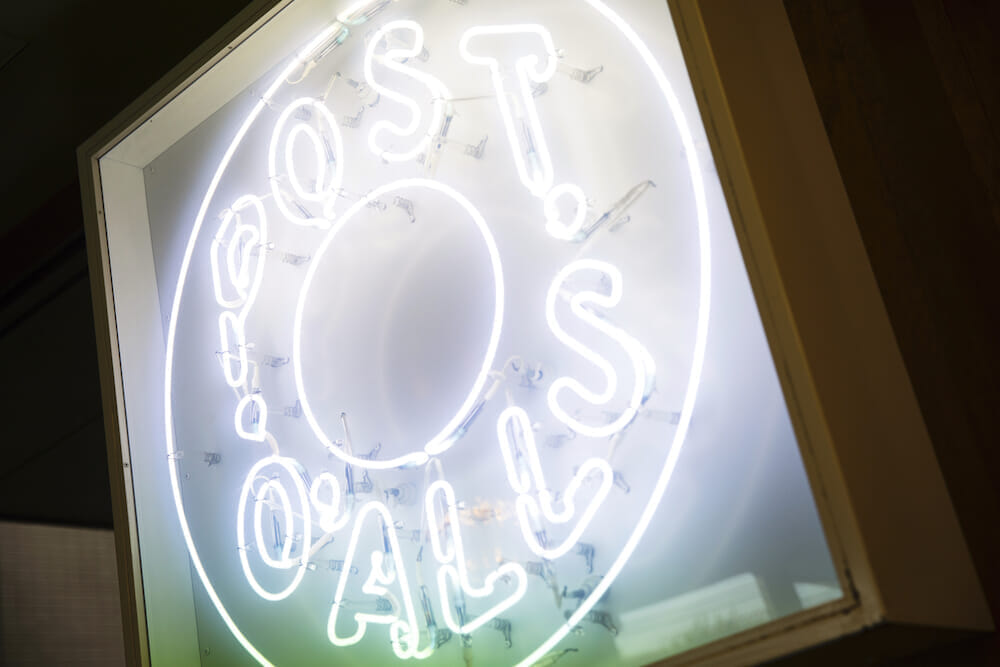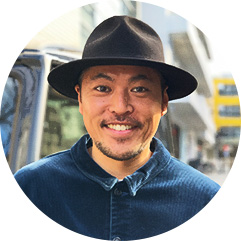POST OVERALLS, which moved its base of operations from New York to Tokyo in 2019 and opened its first directly managed store in the brand's history at the end of August, has been attracting many fans for 25 years since its debut at the fashion exhibition "MAGIC" held in Las Vegas in January 1993. The brand continues to attract many fans as a brand full of originality that captures vintage workwear from a completely new perspective never seen before. What is the desire of an American brand by a Japanese designer to return to Japan and open a store in Tokyo? To find out, we interviewed the designer and representative, Takeshi Ohbuchi.
PROFILE
Born in 1962 . Born in Tokyo, moved to the U.S. at the age of 25. With respect for functional clothing derived from vintage workwear, he mixes various styles of authentic sewing, details, and fabrics. 25 years based in New York, he has been making new timeless made-in-USA clothes, and from Spring/Summer 2019, he will relocate to Tokyo. The brand has relocated to Tokyo and re-launched in Spring/Summer 2019.
I started thinking about why we continue to make them in the U.S. .
Congratulations on your 25th anniversary! Looking back over the past 25 years, how do you feel?
I guess I just found out, that's the honest answer. I'm sure a lot happened, but I don't really remember the details (laughs). . As for the brand, nothing seems to have changed, but it seems to have changed little by little.
And at this time, you moved your base of operations to Tokyo. What was the reason?
Actually, I had been thinking about coming back to Tokyo for several years. When Post Over Alls debuted in 1993, it was a time when American manufacturers were beginning to move their production overseas. However, there were still sewing factories in the U.S., and there were still stores that sold American-made fabrics. I still respected American workwear, so at that time, the best way to stick to products made in the U.S. using American fabrics was to be based in the U.S. . As time has passed and technology has evolved, what could only be done in the U.S. back then, can now be done in Japan. In fact, Japan is even better than the U.S. when it comes to reprinting vintage-style fabrics and parts.
So you don't have much reason to continue making products in the U.S. anymore?
Yes . . Also, after living in the U.S. for so many years, I have more and more times felt that the flow of time has changed. I wonder what I would have worn and how I would have dressed if I had lived in Japan all those years. I wondered. Even in New York, time moves very slowly. . I had a lot more stimulation when I was in Japan.
As a creator, it's an important part of the process, isn't it?
Yes, that's right. When I lived in the U.S., I would come back 3 to 5 times a year, but when I arrived at the airport in Japan wearing the samples I made in the U.S., I felt like taking off those clothes. It's just not the same. I honestly had to think about the fact that I didn't want to wear the clothes in Japan, even though the brand was made in the U.S. and sold in Japan. Also, it costs too much to make the clothes in the U.S., and I am an only child, so I am naturally concerned about my parents and so on.
. I simply thought, "What do I want to wear now?
. There were a lot of factors involved.
After all, food tastes best in Japan (laughs). We were making made-in-USA clothes and operating as an American brand, but our target audience is people who are interested in vintage and like clothes. Then they are not American, but British or French. And most of all, Japanese. . I can say this now, but the first thing I gave up when I started living in the U.S. was food and clothes.
I think the "Made in the U.S.A." is one of the charms of "Post Overalls," but what about production in the future?
Basically, most of our products are made in Japan starting this spring/summer. . There are many aspects of what to do with the country of production that cannot be illustrated simply by the aforementioned technological advancement in Japan. Sometimes it is easier to communicate with factories in the U.S., and when I was in the U.S., even if I input various things in Japan, it was the New York office that gave shape to the final product. However, the most important thing when making clothes is "what do I want to wear now? When I narrowed it down to that one simple point, Japan was the place for me.
I would like to talk directly to customers at the store.
You have also opened your first directly-managed store (and office). What made you decide to open the store?
Until now, I have interacted with wholesalers, but I had never had the opportunity to meet directly with users who actually wear our clothes. I was very interested in talking with them.
. And I am still curious about the location of Hachimanyama (Kamitakaido, Suginami-ku, Tokyo).
Actually, my hometown is close by, and I have known the area since I was a child. . This place was also a game center when I was in junior high school. Before that, I think it was a late-night restaurant before family restaurants were built. . Anyway, it had a cool, slanted appearance. . and there was also a connection that it happened to be an old friend of mine who owned the property before we opened the restaurant. Of course, I wondered how this place would look from a business standpoint. But I thought that if I wanted to go out on weekends, I should go to the suburbs, not Shibuya or Harajuku. . I thought it would be more natural, so I decided on this location.
What do you think about the design of the store?
When my friend owned it, he used it as a warehouse, so I asked Mr. Ishikawa of Pacific Furniture Service to completely redecorate the interior. I learned this later, but there was a reggae bar I loved that I went to when I was in high school , and it was really cool. Except for the owner, it was actually Mr. Ishikawa, who later became Mr. Ishikawa, who was in charge of that bar.
. I feel a connection with you. What did you request from Mr. Ishikawa in terms of interior design?
It is not the America that exists in the U.S., like "America in Japan," but something a little more humid. To be more specific, I asked them to express "the America that existed in Japan in the 1950s and 1960s.
. My stance of making what I want to wear has not changed.
The store is lined with dead stock from the brand's early days, as well as new items.
Once again, the fit is totally different. Like my own clothes, when I started the brand, the mainstream was large sizing and pants were dowdy. . When I think about it now, it's impossible, but on the contrary, for younger people, it has become the norm again. I would like to see how people of various generations, including old and new models, wear these clothes. This is the reason why we have deadstock items on display.
. Finally, what are your future plans?
. The base of making what I want to wear will not change. However, since we have moved from the U.S. to Japan, what we want to wear will inevitably change, and what we make will also change. If there is something that we cannot make by ourselves, it would be good to collaborate with other manufacturers. For example, if we think that even vintage clothing can be made better by changing the fit, we would like to make that as a brand. . In the future, we would like to develop both stores and accessories, if we find something we like.
Photo_Katsunori Suzuki
Text_Yasuyuki Ouchi
POST O'ALLS STORE
Address: 1F, 1-14-10 Kamitakaido, Suginami-ku, Tokyo
Phone: 03-5942-1545
Hours: 12:00 - 20:00
Closed: Wednesday
http://postoveralls.com
https://www.instagram.com/postoalls/










